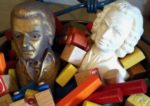Essential Skills for the Transferring Developing Pianist: Part 3
This just in from QoTS: the third installment of essential skills that most middle intermediate to advanced transfer students would do well to develop.
Memory 101
Use theory to help you to chunk bits of information. For example: there may be more than 20 notes within two measures, however, they may belong to just one or two chords. So, instead of remembering 20+ individual pitches and their locations, you only need to remember one or two. Also if you have a memory slip, you can get yourself out by improvising within the known harmonies.
If you began playing the piano later in life or just plain have issues with memory, go ahead and memorize anyway. You learn a lot about the piece through this process. Getting out of the score also allows you to inhabit the piece and connect to it in a different way than when you read it. You don’t necessarily have to perform from memory however. When you go back to the score all the good work you did will still be there and you will feel secure and able to communicate freely.
Even if you memorize and play easily without the score, you should be able to play some repertoire at the same artistic level with the score to prepare yourself to accompany and play chamber music.
Repetition is the key to memory, but random repetition just won’t cut it. Remember the GIGO rule of computer programing–Garbage In Garbage Out.
Divide your piece into small sections to memorize. Then, try playing one 2-4 measure section, singing and doing air piano on the second, play the third section, sing and air piano on the fourth, etc. After you have played all the odd sections that way, then go back to the beginning and reverse the process. I recommend doing this with 1-2 page segments of your piece because you will get very tired. The good news is that you will find out what you don’t know yet. You can keep the frustration level down by leaving the score on the piano at first and only referring to it when you must.
Be sure you can imagine the entire piece away from the piano. Be able to visualize everything and imagine the correct balance of voices, as well as every dynamic and expressive element. Anywhere in the piece where you have trouble doing this is a sure fire future memory slip just waiting to happen.
Pedaling (Damper or Right Pedal)
The pedal must breathe. There are many pedal techniques. In order to become one with the pedal, you need to develop your ear so you can hear the effect you are trying to achieve. Eventually your foot automatically responds and thins out or deepens the pedaling as long as you stay aware of the sound.
Some kinds of pedaling have little to do with the actual musical rhythm of the piece and a whole lot to do with movements of the hands and fingers.
Direct pedal is usually the first type of pedaling learned. The foot generally goes up and down exactly with the fingers. A waltz bass pedal is a kind of direct pedal. Think Oom-pah-pah. Your foot goes down when you play Oom and up on either the first or second Pah. And, just because this is called a waltz bass pedal doesn’t mean you can’t use the same technique in any meter.
Syncopated or overlapping pedal connects melody tones and /or changing harmonies. Let’s say you have two harmonies. You put your foot down on the first chord and leave it down until after you play the second chord. As the pedal is changed, there is a blurring of the first and second chord for a split second after which the second chord is the only one still sounding. This only works if you still have your fingers on the bottom of the second chord until your foot is down again. As you get better at this, you can control how clean (fast change) or blurred (slower change) you want each pedal to be.
In all kinds of pedaling, one can press the pedal down a small bit, all the way, and everything in between. This is usually referred to as half or quarter pedaling. The pedal is not an off on switch! You can change the texture and vary the color in a piece by varying the depth of the pedaling.
Flutter or vibrato pedaling is a technique that allows a bass note or harmony to sound through with minimal blurring to the other voices. It is essential in many romantic, impressionistic, and modern works. And incidentally, it is employed exactly as the name suggests.
The catch pedal is the most complicated to explain. No one ever told me how to do it–my ear just told my foot what it wanted to hear. Later I found out that the technique had a name and I wasn’t the only one who had ever done it. Essentially, your foot catches a harmony or note just before it changes. In catch pedaling the majority of, say a measure, is played with no pedal. This allows for clean lines and textures that are not thickened. This is a very discrete pedal technique which comes in really handy in Classical and Baroque literature.
Pedaling (Una Corda or Left Pedal)
The left pedal is like a mute is on a wind or string instrument. On a grand piano the action shifts over so that the hammer either hits fewer strings or hits a single string off center. The sound of music played with the Una Corde pedal down has a different color or timbre. The sign to use the left pedal is UC or Una Corda. The sign to stop using the left pedal is Tre Corde. Of course, much of the time the use of the left pedal is left to the discretion of the individual performer.
A Personal Viewpoint & Listening
In order to become an artist rather than someone who merely plays the piano well, you need to develop a personal viewpoint for each piece you play. Researching your pieces and composers will help you to connect to the time period and the composer’s intent. It is up to you to choose to either take your listeners back to the past or to find modern parallels that bring the piece into our time. In any case, there is a sharing of the piece between you and the composer.
Musical language and style are absorbed by listening to music–lots of it! Just because someone plays better than you do, don’t assume they are inherently more talented. It may be that they have more experience than you, in time spent at the keyboard and/or in time spent listening to music of many styles.
It isn’t necessary to stop everything else while you listen in order to help yourself get better. Of course, during some of your listening you should give a piece your entire attention. Try for a nice balance.
It is important to listen to all kinds of music when discovering a composer. For example, if you are listening to Mozart, include piano works and orchestra, opera, and chamber works. Starting a regular program of listening can be daunting. Start with something you are interested in and let it lead you forward.
Listening doesn’t have to be expensive. Most radio stations have live streaming and/or podcasts of their programs available. There are free services such as Pandora Radio which allow you to listen anytime to composers you choose. Download services such as iTunes have a large library of downloadable performances–most for a dollar each. YouTube is a treasure trove of performances by some of the greatest pianists in the world.


